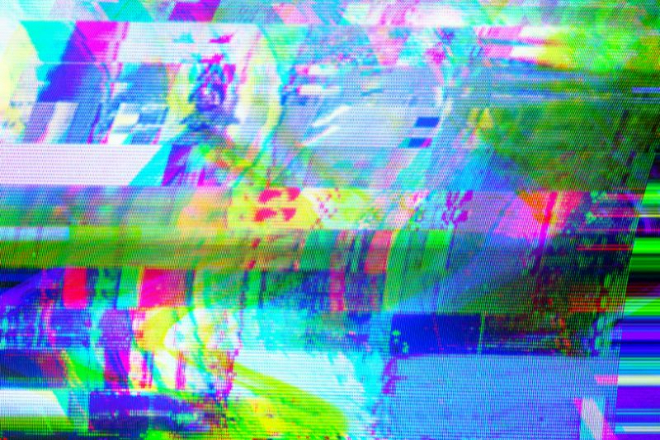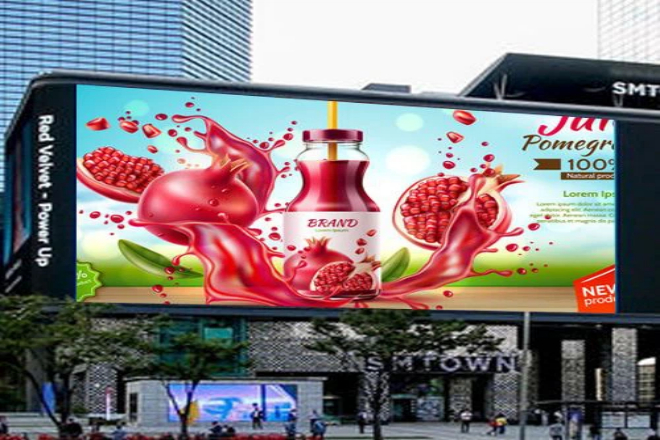مقدمة

In today’s information age, full-color شاشات عرض LED have been widely used in advertising, information broadcasting, stage performances, and other fields.
However, during use, we sometimes find mosaics on the display screen, which seriously affects the display effect and user experience. How to solve it?
1. Analyze the reasons for the mosaic phenomenon of full-color LED display screen

The mosaic phenomenon of full-color LED display screens is indeed a headache. Next, let’s talk about the reasons behind this phenomenon and try to explain it in easy-to-understand words.
1). مزود الطاقة problem
- The power supply stability is not good, or the fluctuation is too large:
Lmagine that you are using an electric light, and suddenly, the voltage is unstable. Will the light flash or become dim? The same is true for full-color LED display screens.
If the power supply is unstable, the color of the lamp beads will change, just like a mosaic.
- A low-quality power supply may cause insufficient or unstable power supply:
Just like you bought a cheap power bank, but it ran out of power after charging for a while, or the mobile phone always prompts you that the power is insufficient when charging.
If the full-color LED display uses such a low-quality power supply, various problems will occur, and the mosaic phenomenon is one of them.
2). Control card problem
- The control card is of poor quality or incompatible with other components:
The control card is like the brain of the display, responsible for receiving and processing information.
If this “brain” is of poor quality or does not fit in with other components, the display will definitely not know what to display, the displayed picture will be messy, and the mosaic phenomenon will appear.
- Control card failure causes abnormal display image:
If the control card is broken, it is like your computer’s motherboard has a problem, and you can’t do anything.
The same is true for the full-color LED display. If the control card fails, the picture will definitely not come out, or it will come out in a mess.
3). Palette problem
- Irrational palette design, surface shedding, oxidation, and other problems:
The palette is like a painter’s palette, used to adjust the color and brightness of the lamp beads.
If this palette is not well designed, or the surface falls off and oxidizes after a long time of use, the painting will definitely not look good, and the mosaic phenomenon will appear.
- Poor consistency between lamp beads:
The full-color LED display is composed of many lamp beads. If the colors and brightness of these lamp beads are different, the displayed picture will definitely look like a big mosaic.
4). Signal line problem
- The cable connecting the LED display is broken, short-circuited, or not firmly connected:
The signal line is like a bridge between the display and the signal source. If the bridge is broken, collapsed, or shaky, the information will definitely not be transmitted, or it will be wrong if it is transmitted.
If this happens to the full-color LED display, the mosaic phenomenon will definitely appear.
- Connection failure between the signal source device and the display:
Just like your mobile phone cannot connect to Wi-Fi, it may be because of a problem with the router or the mobile phone itself.
If the full-color LED display cannot connect to the signal source device, or it is connected but the signal is not good, the displayed picture will definitely be messy.
5). Driver board failure
- The driver board is responsible for controlling the brightness and color of the LED:
The driver board is like the “driver” of the display, responsible for driving (that is, controlling the brightness and color of the lamp beads). If there is a problem with this “driver,” the car (display) will definitely not drive well, and the mosaic phenomenon will appear.
6). معدل التحديث mismatch
- The refresh rate of the LED display does not match the refresh rate of the signal source:
The refresh rate is like how many pictures are changed per second when you watch a movie. If the refresh rate of the display is different from the refresh rate of the signal source, the picture will definitely look incoherent, just like a mosaic.
7). Other factors
- The high ambient temperature causes the internal components to overheat:
If the full-color LED display works for too long or the ambient temperature is too high, the components inside will heat up.
If it is too hot, these components may break or work abnormally, and the mosaic phenomenon will appear.
- Module failure, cable failure, etc.:
Just like your mobile phone sometimes suddenly goes black, it may be that the screen is broken, or there may be a problem with a component inside.
The same is true for full-color LED displays. If the module or cable is broken, the displayed picture will definitely be messy.
In general, there are many reasons for the mosaic phenomenon on the full-color LED display screen, which may be power supply problems, control card problems, color palette problems, signal line problems, driver board failures, refresh rate mismatches, and other factors.
So, if your display screen has a mosaic phenomenon, don’t worry; first, find out where the problem is, and then prescribe the right medicine, which can generally be solved.
2. What are the specific measures to solve the mosaic phenomenon on the full-color LED display screen?

For the mosaic phenomenon on the full-color LED display screen, we can take a series of specific and practical measures to solve this problem.
Below, I will use more popular language to introduce these measures to you in detail.
1). Power supply optimization
1.1). Use high-quality power supply:
We have to choose power supplies with a good reputation and excellent quality to ensure that the voltage is stable and will not fluctuate.
Just like the electricity we use at home, the voltage is stable, and the electrical appliances can work normally, and the same is true for the display screen.
Although some power supplies are cheap, the quality is not guaranteed, and there may be various problems when using them. So, don’t save a little money and end up with the display screen always having problems.
1.2). Avoid problems with AC power lines, power filter circuits, and wires:
The power line should be checked regularly to see if there are any aging or damaged parts, and they should be replaced in time.
The power filter circuit should also be paid attention to. It is like the “security” of the power supply. Make sure it works properly, and don’t let miscellaneous signals interfere with the display screen.
The wires should also be selected well; don’t use the inferior ones. Otherwise, the current can’t be transmitted, or it is unstable, and the display screen will definitely have problems.
2). Control card replacement and upgrade
2.1). Choose a professional control card brand:
The control card is like the “brain” of the display screen. You have to choose a smart “brain.” Therefore, we have to choose those professional and well-known brands with guaranteed quality and good compatibility.
2.2). Regularly check the control card status:
The control card may be tired after working for a long time, and it may also have some minor problems. Therefore, we have to give it a “physical examination” regularly to see how it works and whether there are any problems that need to be solved.
2.3). Replace the faulty control card in time:
If the control card is really faulty, don’t hesitate to replace it with a new one. Otherwise, the display may show a mosaic phenomenon because the “brain” is not working well.
3). Improve the color palette
3.1). Replace the color palette with a reasonable design and high quality:
The color palette is like a painter’s palette; you have to choose a good one. Therefore, we have to change to a reasonable design and high-quality palette to make the color of the display more vivid and uniform.
3.2). Regularly check and maintain the color palette in daily maintenance:
The color palette also needs to be maintained frequently, dust must be wiped off, and the connection must be checked to ensure it is firm. In this way, it can better serve the display.
4). Signal line optimization
4.1). Choose a professional transmission line:
The signal line is like a “bridge” between the display and the signal source, and a solid “bridge” must be selected. Therefore, we have to use a professional transmission line to ensure that the signal can be transmitted steadily.
4.2). Ensure the circuit is clean and dry:
The signal circuit must be kept clean and dry, and it must not get wet or dusty. Otherwise, the signal may be interfered with, and the display may show mosaics.
4.3). Check and repair the interface failure of the signal line:
The interface is like the joint of the “bridge,” and it must be connected firmly. Therefore, we must check the interface regularly to see if there is any looseness, oxidation, or damage and repair it in time.
5). Driver board maintenance
5.1). Regularly check the driver board status:
The driver board is like the “driver” of the display, and it must be ensured that it works properly. Therefore, we must regularly give it a “physical examination” to see if there is any problem with it.
5.2). Replace the faulty driver board in time:
If the driver board really has a problem, don’t delay it, and replace it with a new one as soon as possible. Otherwise, the display may show mosaics because the “driver” is not strong enough.
5.3). Ensure the compatibility of the driver board with other components:
The driver board and other components must “get along.” Therefore, when we choose the driver board, we must ensure that it is compatible with other components so that the display can work more smoothly.
6). Refresh rate matching
6.1). Adjust the refresh rate of the LED display:
The refresh rate is like how many pictures are changed per second when watching a movie. If the refresh rate of the display does not match the refresh rate of the signal source, the picture may look discontinuous, like a mosaic.
Therefore, we have to adjust the refresh rate of the display to match it with the refresh rate of the signal source.
7). Other measures
7.1). Control the working temperature of the display:
The display may heat up after working for a long time. If the temperature is too high, the components inside may “get heatstroke” and work abnormally. Therefore, we have to control the working temperature of the display and don’t let it get too hot.
7.2). Clean the panel regularly, adjust the brightness, replace unusable pixels, etc.:
The display panel should be wiped frequently to keep it clean and bright. The brightness should also be adjusted according to the actual situation, not too bright or too dark. If a pixel is broken, replace it with a new one immediately. Don’t let a small problem affect the effect of the entire display.
In short, it is not difficult to solve the mosaic phenomenon of full-color LED display. As long as we follow the above measures, I believe that the display will be restored to its original state and show a clearer and brighter picture.
3. So, how can the mosaic phenomenon of full-color LED display be prevented?

To prevent the mosaic phenomenon of full-color LED displays, we can actually start from the three aspects of selecting things, using things, and the environment. Let me talk about how to do it in detail.
1). Choose high-quality components
- Buy goods and use the right ones:
When buying LED display screens, we have to choose components that are of good quality. LED lamp beads should be selected to emit light evenly and stably, preferably from the same batch, so that the color can be consistent and mosaics cannot be produced easily.
Key components such as driver boards and control cards must also be selected. Don’t be greedy and buy inferior ones. Otherwise, there will be many problems in use, and mosaic phenomena will follow.
The signal line must also be selected professionally. Don’t use the kind of random wires. Otherwise, the signal transmission will not be good, and the display screen will definitely have problems.
2). Develop good usage habits
- Don’t turn it on and off frequently:
The LED display is not a toy. Don’t turn it on and off frequently; otherwise, it will be easily damaged. Use it well when you use it, and let it rest when you don’t use it.
You also need to maintain it regularly, wipe off the dust, check whether the line connection is firm and whether the سطوع and contrast are adjusted appropriately.
If you find that any pixel is not lit, replace it with a new one immediately. Don’t drag it. Otherwise, the mosaic phenomenon will become more and more serious.
- Treat it gently:
When using the display, don’t be too rude; don’t hit it or knock it hard. Otherwise, the parts inside will be easily damaged.
Also, don’t let it light up at the brightest light for a long time, which will easily burn it out, just like our eyes will feel uncomfortable when looking at strong light for a long time.
3). Environmental control
- Give it a good environment:
The working environment of the LED display is very important. Don’t be too hot or too cold. If it is too hot, it is easy to “heatstroke,” and if it is too cold, it may “freeze.” So, we have to find a place with a suitable temperature for it.
The humidity must also be controlled, not too wet or too dry. Too wet can easily cause the circuit inside to short-circuit, and too dry can easily generate static electricity, which is not good for the display.
Also, don’t let it eat too much dust, as too much dust can easily block its “breathing port” and affect its work. Therefore, we have to clean it regularly and keep it clean.
4). In addition, I have a few tips to tell you:
- Find a professional to install:
When installing the LED display, don’t do it yourself; find a professional to install it so that it can be installed well and used for a long time.
- Don’t fall behind in software updates:
Nowadays, technology is changing with each passing day, and the LED display software is constantly updated. We have to update the software regularly to keep it up-to-date and more convenient to use.
In short, it is not difficult to prevent the mosaic phenomenon of the full-color LED display. As long as we choose good components, develop good usage habits, control the environment, and regularly do maintenance and update the software, we can keep our display in the best condition!
خاتمة
In summary, the reasons for the mosaic phenomenon of full-color LED display screens may involve the power supply, control card, color palette, signal line, driver board, and other aspects.
In order to effectively solve this problem, we need to start from multiple angles and take targeted measures to optimize and deal with it.
وأخيرًا، إذا كنت تريد معرفة المزيد عن شاشات العرض LED، يرجى الحصول على اتصال معنا.
